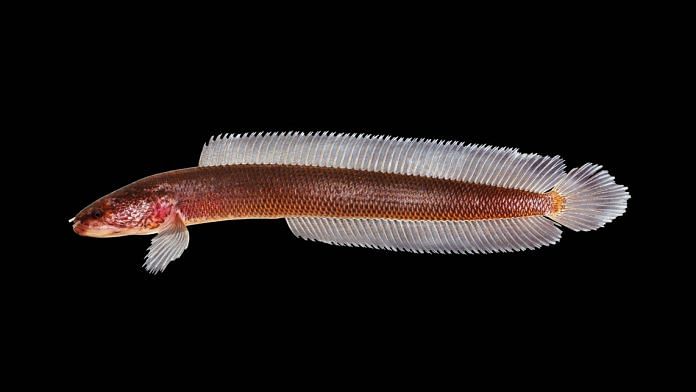Kochi: In a find that has excited Asia’s ichthyologists, a team of British and Indian scientists have discovered a brand new species of snakehead, a type of fish, from a paddy field in Kerala.
Their findings, published in the international journal Zootaxa Thursday, states that the new species is physically and genetically distinct from all other snakehead species in the world. The scientists have named the new snakehead species as the Gollum snakehead, with the scientific name Aenigmachanna gollum.
The ‘Gollum’ is a reference to J.R.R. Tolkien’s Gollum, as according to the scientists, the new snakehead could have modified its physical features to adapt to life underground just like the fictional character from The Hobbit.
According to their findings, the new species has an elongated cylindrical body, long fins and large scales on its head, all characteristic of snakeheads. But some of its features are rather unusual: Its body is unnaturally narrow for a snakehead and its hues seemed muted when compared to the usually bright colours most snakeheads sport.
“These are features mostly seen in subterranean fish that dwell in natural springs and channels under the earth,” said Rajeev Raghavan, an assistant professor at Kochi’s Kerala University of Fisheries and Ocean Studies (KUFOS), who is among the scientists behind the study. “The narrow body, for instance, could be an adaptation to narrow water channels underground.”
Snakeheads are fish that live up to their name: Their heads sport large scales, giving them a rather snake-like appearance. The name may be unfamiliar in India where the often brightly-coloured predatory fish occur naturally in streams and rivers.
Snakeheads, however, are notorious in many other parts of the world, for some have invaded ecosystems in continents including Europe and North America. For instance, the northern snakehead is native to parts of China and East Asia but it has been identified as one of the eight (out of a list of 329) invasives in the European Union that pose a “very high” overall threat to biodiversity and ecosystems there.
Also read: Why thousands of Indians continue to die of snakebites
Find from a Whatsapp post
For the scientists, it all began when Mohammad Ajeer, a 25-year-old industrial worker and fishing enthusiast, scooped into his palm two nine-centimetre long fish from the flooded paddy fields near his home in Oorakam in Kerala’s Malappuram district in September 2018.
He had never seen anything like them — eel-like, with transparent fairy-like fins framing their predominantly brown bodies.
The photographs that Ajeer posted on Facebook and a Whatsapp group piqued the interest of Raghavan. The assistant professor and his colleagues — Ralf Britz (London Natural History Museum), V.K. Anoop (KUFOS) and Neelesh Dahanukar (Indian Institute of Science Education and Research, Pune) — obtained the fish specimens from Ajeer to study them in detail.
The new snakehead could have evolved adaptations to a subterranean life over millions of years, suggest the authors in their study. The team also observed that one live specimen could not keep swimming in the water column, unlike normal snakeheads. Its potential inability to remain buoyant in water is another feature common in subterranean fish, they add. But this is only a behavioural observation and detailed studies would be required to confirm this, agrees Raghavan.
The team’s genetic analyses, however, leave room for no doubt: The Gollum snakehead is indeed a distinct species. In fact, portions of the fish’s mitochondrial DNA that the team studied reveals that it is genetically so different from 37 other snakeheads in Asia and Africa, that it has been classified into an entirely new genus, Aenigmachanna, a name to mark how much of an enigma the fish still is. More studies are required to determine its habitat and possibly subterranean lifestyle, they add.
‘A big deal for ichthyology in Asia and Africa’
The fish is indeed a subterranean species and its discovery is a “big deal” for ichthyology in Asia and Africa, said Rohan Pethiyagoda, a leading fish taxonomist currently with Syndey’s Australian Museum. He was not part of the study.
“This is the first subterranean snakehead anywhere in the world, so it is of enormous interest,” he wrote in an email. “Unlike many subterranean fish that are blind and unpigmented, this species has retained its eyes and its scales still carry some pigment. This suggests that its natural habitat is not completely dark.”
This “unique discovery”, of a fish that shows dual characteristics of subterranean and surface fishes, also poses several questions regarding its biological features and biogeography, says A. Bijukumar, professor and head of the Department of Aquatic Biology and Fisheries at the University of Kerala who was also not involved in the study.
“As air-breathing channiform fishes have close kin in both Africa and Asia, Aenigmachanna gollum may shower light on a possible early Cretaceous divergence of the African and Asian channids and recent dispersal of this species between continents,” Bijukumar wrote in an email.
The (genetic) lineage that the new genus represents appears to have diverged well before its African and Asian cousins themselves separated, according to Pethiyagoda. Future genetic work could help address questions such as whether it pre-dates the Deccan volcanism and throw light on India’s Gondwanan relationships, he added.
Also read: American scientists were able to ‘revive’ brains of dead pigs
Aathira Perinchery is a Kochi-based wildlife biologist-turned-science writer who loves reading and writing about wildlife science, ecology, communities and conservation in India.



